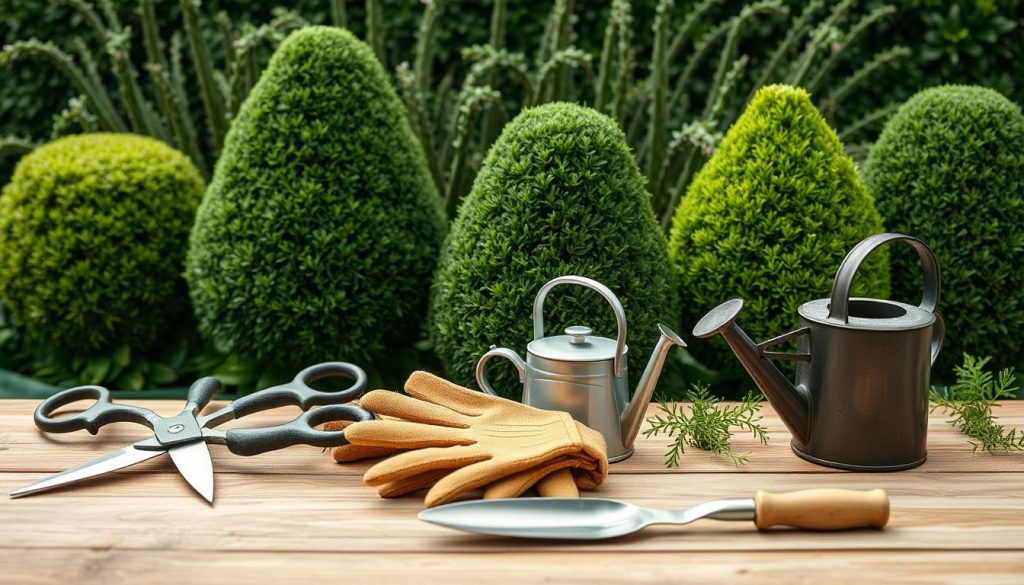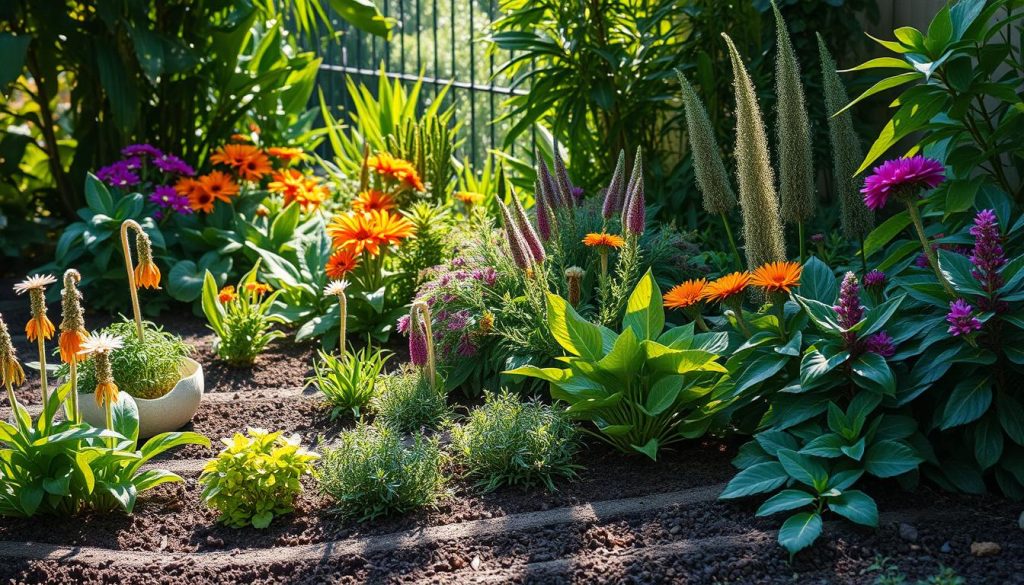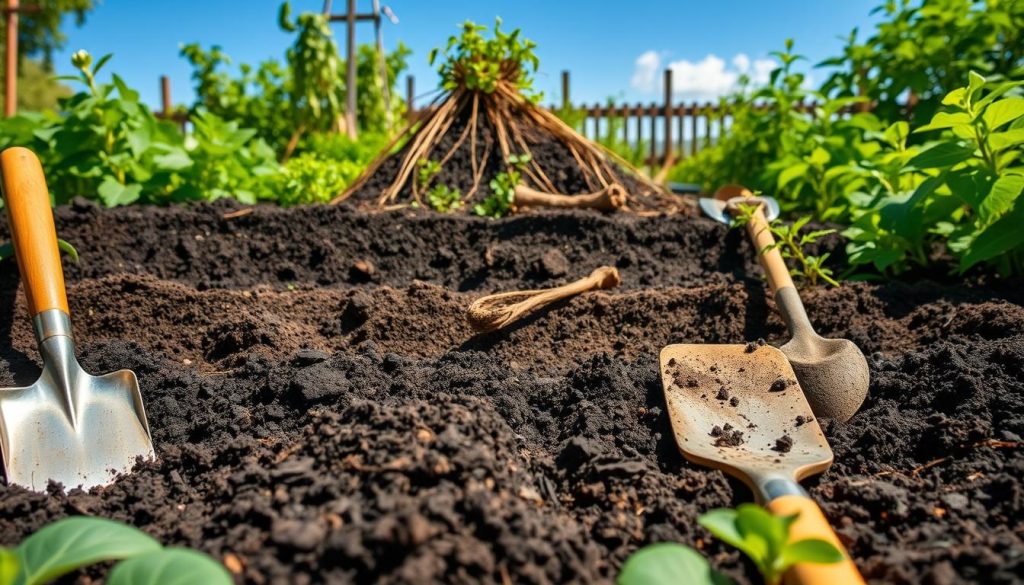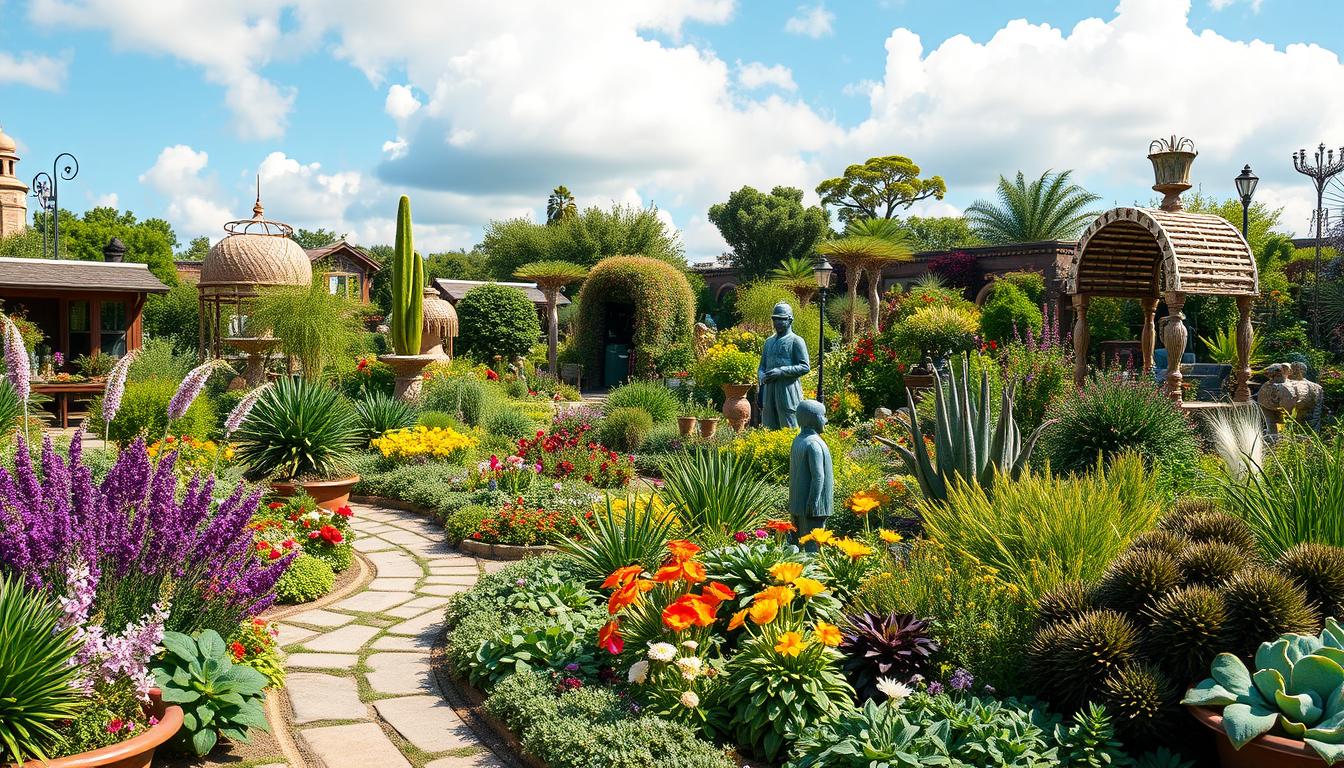I’m thrilled to share my love for specialty gardening with you. This unique way of growing plants has changed my outdoor area and improved my gardening skills. Whether you’re just starting or have been gardening for years, specialty gardening opens up a world of creative options.
Specialty gardening lets me show off my personality with plants. It’s great for adding green to small areas or making eye-catching spots in bigger yards. As we explore this exciting field, I’ll show you different types of specialty gardens and how they can make your home or community better.
Let’s dive into the world of specialty gardening together. I’ll give you advice on picking the right plants, designing your garden, and keeping it up. Get ready to be creative and turn your outdoor space into a special place that shows off your gardening passion.
What is Specialty Gardening?
Specialty gardening is a unique way to grow plants. It focuses on specific themes, techniques, or types of plants. I find it fascinating how it lets me express my creativity and passion for plants in new ways.
Understanding the Concept
Specialty gardening is more than just growing vegetables or flowers. It’s about creating gardens with a special purpose or style. For example, I might design a garden to attract butterflies or build a rock garden with plants that don’t need much water. This way, I can make my garden reflect my interests and the local environment.
Different Types of Specialty Gardening
There are many exciting types of specialty gardens to explore:
- Butterfly gardens: Filled with nectar-rich flowers to attract these beautiful insects
- Rock gardens: Featuring hardy plants that thrive in rocky, well-drained soil
- Water gardens: Incorporating ponds or fountains with aquatic plants
- Organic gardens: Using natural methods to grow food without synthetic chemicals
- Zen gardens: Creating peaceful spaces with carefully arranged rocks and plants
Organic gardening is often a big part of specialty gardening. By avoiding synthetic pesticides and fertilizers, I can create a healthier environment for plants, wildlife, and myself. This approach fits perfectly with my goal of sustainable and eco-friendly gardening.
| Specialty Garden Type | Key Features | Benefits |
|---|---|---|
| Butterfly Garden | Nectar-rich flowers, host plants | Attracts pollinators, enhances biodiversity |
| Rock Garden | Drought-resistant plants, rocky terrain | Low maintenance, unique aesthetics |
| Organic Garden | Natural pest control, compost use | Healthier produce, environmentally friendly |
Benefits of Specialty Gardening
Specialty gardening brings many benefits beyond just growing plants. It has changed my life and surroundings in big ways.
Enhancing Mental Wellness
My specialty garden is like therapy for me. Taking care of plants and watching them grow gives me a sense of purpose. It helps me relax and find peace in nature’s rhythm.
Boosting Home’s Aesthetic Appeal
My specialty garden has made my home look better. Whether it’s a vertical herb garden or a colorful butterfly garden, it makes my property stand out. A well-kept garden can even increase my home’s value.
Contributing to Sustainability
Using permaculture in my garden helps preserve our ecosystem. It supports biodiversity, attracts good insects, and cuts down my carbon footprint. It’s fulfilling to know my hobby helps make our city greener.
- Reduces stress and improves mental health
- Enhances property value and curb appeal
- Promotes biodiversity and sustainability
- Provides fresh, organic produce
- Creates a unique outdoor living space
Getting Started with Specialty Gardening
I’m excited to start specialty gardening! It’s a fun hobby that lets me be creative and grow special plants. First, I need to pick a specialty and see how much space I have.
Choosing My Specialty
There are many cool options in specialty gardening. I’m thinking about hydroponics for my indoor garden. This method lets me grow plants all year, no matter the weather outside. I can start small or go big with a hydroponic setup.

- Vertical gardening for maximizing space
- Succulent gardens for low-maintenance beauty
- Herb gardens for fresh flavors in my cooking
- Butterfly gardens to attract pollinators
Assessing My Space
Next, I need to check my space. I have a small balcony with lots of sunlight. It’s great for container gardening or vertical setups. Inside, I can make indoor gardens in my living room and kitchen. These spots are perfect for hydroponics or small herb gardens.
By matching my specialty to my space, I’m ready for success in specialty gardening. I’m excited to watch my garden grow!
Essential Tools for Specialty Gardening
Having the right tools is key for my specialty gardening projects. From basic hand tools to specialized equipment, each tool is vital. Let’s look at the must-have tools and some cool gadgets for better gardening, especially for greenhouses and topiary.
Must-Have Gardening Tools
For my specialty gardening, I use these essential tools:
- Pruning shears for precise cuts
- Loppers for thicker branches
- Hand trowel for planting and transplanting
- Garden fork for soil aeration
- Watering can with adjustable nozzle

Innovative Gadgets to Consider
I love trying new gadgets to make gardening easier. Here are some innovative tools I’ve found useful:
| Gadget | Use | Benefit |
|---|---|---|
| Smart irrigation controller | Greenhouse cultivation | Optimizes watering schedule |
| Soil moisture meter | All garden types | Prevents over/under watering |
| Electric pruning shears | Topiary | Reduces hand fatigue |
| LED grow lights | Greenhouse cultivation | Extends growing season |
These tools have greatly improved my gardening. They make tasks like greenhouse work and topiary shaping easier. By choosing quality tools and trying new gadgets, I’ve elevated my gardening skills.
Choosing the Right Plants
Choosing the right plants is key to a successful garden. I look for both native and exotic plants to make my garden stand out.

Native Plants for My Area
I prefer native plants in my garden. They fit my local climate and help local ecosystems. Native plants need less water and care, making them great for eco-friendly gardening.
I find native plants at local nurseries or through my state’s native plant society.
Exotic Plants for Unique Touches
Exotic plants add flair to my garden. Bonsai trees, for example, bring elegance. They need careful pruning but look amazing.
Herb gardens are also a great choice. They’re beautiful and useful. I can grow herbs like basil and rosemary in small spaces. This gives me fresh herbs and adds nice scents and textures.
- Choose native plants for easy maintenance
- Add bonsai trees for elegance
- Incorporate herb gardens for beauty and function
By mixing native and exotic plants, I create a garden that’s truly mine. It shows off my style and meets my gardening dreams.
Soil Preparation Techniques
Great soil is the heart of a thriving garden. I’ve found that the right soil preparation is crucial for success in organic gardening and permaculture. Let’s explore some key techniques to prepare your soil for planting.
Testing My Soil Quality
Before I start improving my soil, I test its quality first. This tells me what nutrients are there and what’s missing. I use a home soil testing kit to check pH levels and nutrient content. Here’s a quick guide to the best soil pH levels for various plants:
| Plant Type | Ideal pH Range |
|---|---|
| Vegetables | 6.0 – 7.0 |
| Fruit Trees | 6.0 – 6.5 |
| Herbs | 6.0 – 7.0 |
| Acid-loving Plants | 4.5 – 5.5 |
Amending Soil for Optimal Growth
After knowing my soil’s makeup, I work on making it better. In my organic gardening, I add natural amendments like compost, aged manure, and leaf mold. These not only add nutrients but also help with soil structure and water retention.

In my permaculture garden, I build a layered system like natural soil. I start with cardboard to stop weeds, then add green and brown layers. This method, called sheet mulching, creates rich, living soil over time.
By following these steps, I give my garden the best start. Healthy soil means healthy plants, leading to a thriving, sustainable garden ecosystem.
Watering and Irrigation Tips
Keeping my specialty garden well-watered is key to its success. I’ve learned that different plants have unique water needs. Finding the right balance is crucial.
Let’s dive into some effective watering strategies. We’ll also explore innovative irrigation systems that can make my gardening life easier.
Understanding My Plants’ Needs
I start by researching each plant’s water requirements. Some thrive in moist soil, while others prefer drier conditions. I check the soil moisture regularly, using my finger or a moisture meter.
This helps me avoid overwatering, which can be just as harmful as underwatering.
Efficient Irrigation Systems
To save time and water, I’ve implemented efficient irrigation systems in my garden. Drip irrigation works wonders for my vegetable beds and flower borders. It delivers water directly to the roots, reducing evaporation and preventing water waste.
For my container plants, I use self-watering pots. These provide a consistent moisture level.
I’ve also explored hydroponics and greenhouse cultivation techniques. These methods allow me to grow plants using nutrient-rich water solutions. This minimizes water consumption and maximizes growth.
In my greenhouse, I can control humidity levels and water more precisely. This creates ideal conditions for my specialty plants.
| Irrigation Method | Best For | Water Efficiency |
|---|---|---|
| Drip Irrigation | Vegetable beds, Borders | High |
| Self-Watering Containers | Potted plants | Medium |
| Hydroponics | Indoor gardens, Leafy greens | Very High |
By understanding my plants’ needs and using efficient watering systems, I’ve created a thriving specialty garden. It’s both water-wise and productive.
Pest Management Strategies
In my specialty garden, keeping pests away is key for healthy plants. Organic gardening helps manage pests without harming the environment. Let’s look at some strategies I use to keep my urban garden pest-free.
Organic Pest Control Methods
I choose natural pest control methods for my organic garden. Here are some effective ones I’ve found:
- Companion planting to repel pests
- Using neem oil as a natural insecticide
- Introducing beneficial insects like ladybugs
- Setting up physical barriers like row covers
Recognizing Common Pests
Spotting pests early is crucial in urban gardening. I watch out for these common pests:
| Pest | Signs | Organic Control |
|---|---|---|
| Aphids | Curled leaves, sticky residue | Spray with soapy water |
| Slugs | Holes in leaves, slime trails | Beer traps or diatomaceous earth |
| Tomato hornworms | Defoliated plants, large droppings | Handpick or use Bacillus thuringiensis |
Using these organic gardening techniques, I keep my urban garden thriving. It’s rewarding to see my plants healthy and my garden balanced.
Seasonal Care for Specialty Gardens
Seasonal care is key to keeping my specialty garden thriving all year. I’ve found that adjusting my gardening to each season’s needs keeps my garden beautiful and productive.
Spring Planting Essentials
When spring comes, I get my garden ready for new growth. I clean up winter mess and add compost to the soil. For my indoor gardens, I water and fertilize more as the days get longer. In my greenhouse, I adjust the air flow to keep temperatures right.
- Clear out dead plants and weeds
- Test and amend soil pH
- Start seeds indoors for early planting
- Prune perennials and shrubs
Winter Preparations
As winter gets closer, I protect my plants from the cold. For outdoor plants, I use mulch to keep roots warm. My indoor gardens need less water and food during this time. In my greenhouse, I can grow plants longer, but I still watch the temperature.
| Task | Outdoor Garden | Indoor Garden | Greenhouse |
|---|---|---|---|
| Watering | Reduce frequency | Decrease amount | Adjust based on humidity |
| Protection | Apply mulch | Move away from cold windows | Install insulation |
| Maintenance | Remove dead foliage | Dust leaves | Clean and sanitize |
Creating a Garden Design Plan
When I start planning my specialty garden, I focus on creating a space that’s both beautiful and functional. A well-thought-out design enhances my garden’s appeal and makes it more enjoyable to use. Let’s explore how to craft a garden that’s a true reflection of my style and needs.
Designing for Aesthetics and Functionality
I begin by sketching my garden layout, considering the natural flow and focal points. Topiary elements can serve as stunning centerpieces, drawing the eye and adding structure. I might include a bonsai display area for a touch of zen-like tranquility. It’s important to balance open spaces with planted areas to create a harmonious feel.
To ensure my garden is functional, I think about how I’ll use the space. Do I need areas for relaxation, entertaining, or growing vegetables? I make sure to include practical elements like storage for tools and easy access to water sources.
Incorporating Features like Pathways and Seating
Pathways are essential for guiding movement through my garden. I use materials that complement my overall design, such as stepping stones or gravel. These paths lead to key features like seating areas or a bonsai display bench.
For seating, I consider comfortable options that blend with the garden’s style. A bench near my topiary collection or a small patio set surrounded by lush plants creates inviting spots to relax and enjoy my garden oasis.
By carefully planning these elements, I create a specialty garden that’s not only visually appealing but also a joy to experience every day.
Joining Specialty Gardening Communities
I love sharing my passion for specialty gardening with others. It’s exciting to connect with fellow enthusiasts who understand the joys of nurturing unique plants. Joining gardening communities has helped me grow my skills and discover new ideas for my herb gardens.
Finding Local Groups
I’ve found great support in local specialty gardening groups. These gatherings are perfect for swapping tips and tricks. I often attend community events where I can see stunning gardens up close.
It’s inspiring to meet people who share my love for creating beautiful, one-of-a-kind green spaces.
Online Resources and Forums
The internet is a treasure trove for specialty gardening information. I frequently visit online forums to ask questions and share my experiences. Social media groups dedicated to herb gardens have been incredibly helpful.
I’ve learned so much from other gardeners’ posts and photos. These virtual communities keep me motivated and offer fresh ideas for my own garden projects.
By joining both local and online specialty gardening communities, I’ve expanded my knowledge and made new friends. It’s amazing how a shared interest in unique plants can bring people together. Whether I’m seeking advice or showing off my latest herb garden creation, these groups provide endless support and inspiration.

